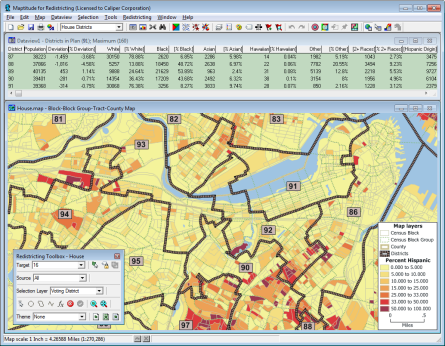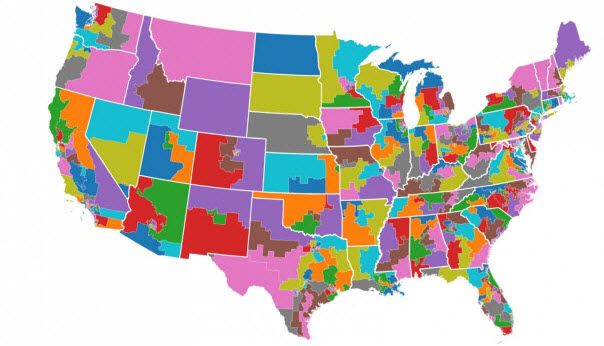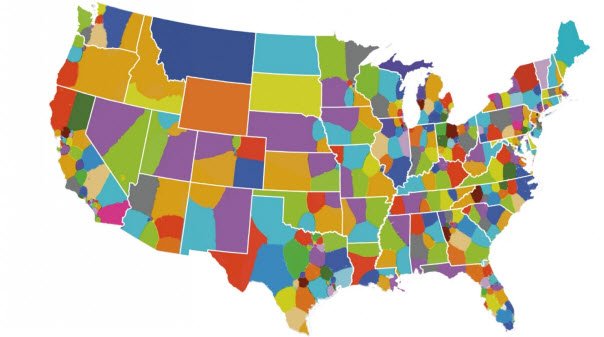How to Get Rid of Gerrymandering:
First, Get Rid of Congress
May 4 2016 “We've got to end the practice of drawing our congressional districts so that politicians can pick their voters, and not the other way around”, President Obama has said. He was referring to the practice of gerrymandering, of political parties rigging districts so as to assure the election of their candidates. It has been with us for two centuries, is manifestly undemocratic, yet the Supreme Court avoids confronting it, and Congress likes things just as they are.
Once every ten years, based on the population census, each state usually must reconfigure its voting districts, first to conform to the number of congressional representatives that its newly-counted population permits, and then to arrive at approximately equal numbers of voters in each district. That upheaval creates a bonanza for the party that controls a state's legislature. All too often they set about packing as many as possible opposition party voters into the fewest districts, while spreading their own voters so that they are the majority in many districts. The result is congressional representation skewed in the ruling party's favor.
Both parties follow the practice. Since 2010, Republicans have held the upper hand, having dominated in the elections of that census year and since. By 2014, they controlled 30 of the 50 state legislatures, up from 16 a decade earlier.
The problem has grown more serious with software technology enabling legislators to gerrymander districts to a greater degree than ever. In the first 10 years of this century, only 22% of the seats in the House of Representatives changed hands. In California, a single seat out of 53 switched party control during those years. The University of Chicago Law Review found that the 2012 congressional districts were the most partisan in at least four decades. House of Representatives Democrats got about 1.5 million more votes than their Republican counterparts but the GOP won 54% of House seats. So locked in are districts that only 59 of 435 of House seats are expected to be competitive this year. Gerrymandering is hardly the sole cause, but it contributes to why we return to Washington the same members despite opinion polls that show abysmal approval ratings of Congress hovering around 10%.
home ruleArticle I, Section 4 of the Constitution leaves it to the state legislatures to set "The Times, Places and Manner of holding Elections for Senators and Representatives". As is often the case, interpretation by the Supreme Court has stretched the words of the Constitution beyond what is there. Nothing in that prescription can reasonably be contorted to include the drawing of districts in advance of those elections, schemes usually meant to be unchanged for ten years until the next census. But the high court has shied from interfering with state control. It has limited its involvement only to instances where gerrymandering sorts voters by race, as in its March review of Virginia's having drawn a strung out district in which to put too many black voters. It ruled against Alabama last year in a similar case. But the Court has not ruled against gerrymandering itself and indeed in 1986 avoided the issue despite those in dissent saying they were “not persuaded that there are no judicially discernible and manageable standards" that could not be devised to decide gerrymander cases. The National Law Journal's Marcia Coyle, who analyzes the Supreme Court hearings on the PBS NewsHour, concludes that "the Supreme Court has pretty much washed its hands of trying to decide whether partisan gerrymandering violates the Constitution".
up to congressBut while the states are given a free hand in choosing the times, places and manners for holding elections, Congress still has the upper hand. Article I, Section 4 continues to say that "the Congress may at any time by Law make or alter such Regulations" and indeed it has done so. In the Apportionment Act of 1842, Congress limited House representatives one to a district and required that a district must be “composed of contiguous territory”, and in 1872 further stipulated that districts “contai[n] as nearly as practicable an equal number of inhabitants”.
hemmed inFailure to change the system means that, while House representatives in heavily gerrymandered districts may be assured of re-election every other November, their risk is shifted to the primaries, where the most ideologically extreme come out to vote. That means a representative running for re-election is vulnerable to the threat of a more extreme challenger. The incumbent will be sent packing if guilty of any deviance from doctrine while in office. That's what happened to Republican Eric Cantor of Virginia, in line to become Speaker when, in a stunning upset, he lost his seat to a candidate further to the right for having "lost touch" with his constituents. One step off the ideological path in the making of laws and a representative has a higher risk of being "primaried" out of office in a gerrymandered district.
a system that guarantees lawsuitsWith Congress content with the status quo, that leaves the problem in the lap of the courts. Lawsuits were filed in 42 states after the district redrawing that followed the 2010 census. Examples:
![]() In a 5-4 decision, with Justice Anthony Kennedy joining the liberal wing, the Court found that the Alabama legislature had based its apportioning on race, packing a district which already had a 72% majority of blacks with 16,000 more. "Bleached of their reliable Democratic voters, the surrounding districts become safe for Republicans", as a Wall Street Journal op-ed writer put it. The four dissenting conservative members of the Court were not perturbed by the overloaded district.
In a 5-4 decision, with Justice Anthony Kennedy joining the liberal wing, the Court found that the Alabama legislature had based its apportioning on race, packing a district which already had a 72% majority of blacks with 16,000 more. "Bleached of their reliable Democratic voters, the surrounding districts become safe for Republicans", as a Wall Street Journal op-ed writer put it. The four dissenting conservative members of the Court were not perturbed by the overloaded district.
![]() By a 5-2 vote Florida's Supreme Court concluded that eight of the state's congressional maps were unfairly drawn because of a "conspiracy" among Florida political operatives who showed the “unconstitutional intent to favor the Republican Party and incumbent lawmakers”, but not before those maps had already been used in the 2012 and 2014 elections.
By a 5-2 vote Florida's Supreme Court concluded that eight of the state's congressional maps were unfairly drawn because of a "conspiracy" among Florida political operatives who showed the “unconstitutional intent to favor the Republican Party and incumbent lawmakers”, but not before those maps had already been used in the 2012 and 2014 elections.
![]() In North Carolina, Republicans captured control of the legislature in 2010 for the first time since just after the Civil War and drew district lines so as to corral 49% of all the state’s African-American voters into a Bantustan of just three of the state’s 13 electoral districts, leaving the remaining districts mostly white. The state's legislature was forced to redraw the lines of two congressional districts when a federal district court ruled that that they had been gerrymandered along racial lines.
In North Carolina, Republicans captured control of the legislature in 2010 for the first time since just after the Civil War and drew district lines so as to corral 49% of all the state’s African-American voters into a Bantustan of just three of the state’s 13 electoral districts, leaving the remaining districts mostly white. The state's legislature was forced to redraw the lines of two congressional districts when a federal district court ruled that that they had been gerrymandered along racial lines.
![]() Redistricting battles often lead to court fights. Charged with redrawing the maps to add four new districts, the Republican majority in the Texas legislature brought forth a map that disadvantaged the very same Latino and black voters who had accounted for 89% of the state's population growth that won the four new congressional seats.
Redistricting battles often lead to court fights. Charged with redrawing the maps to add four new districts, the Republican majority in the Texas legislature brought forth a map that disadvantaged the very same Latino and black voters who had accounted for 89% of the state's population growth that won the four new congressional seats.
![]() When a three-judge panel in Virginia ruled that a congressional map be redrawn so as to give blacks a chance to elect probable Democratic candidates in two districts, not just one, state Republicans appealed to the U.S. Supreme Court, which heard the case in March.
When a three-judge panel in Virginia ruled that a congressional map be redrawn so as to give blacks a chance to elect probable Democratic candidates in two districts, not just one, state Republicans appealed to the U.S. Supreme Court, which heard the case in March.
Because of the Supreme Court's failure to piece together a set of standards, because of Congress members' preference for state control that keeps them in office, the perversion of our supposed democracy continues, and over the last fifty years of civil rights remediation the courts have had to deal with dozens of such cases that Chief Justice John Roberts calls the “sordid business of divvying us up by race.”
another wayA few states have got religion. Seven have now opted to hand the redistricting job to independent commissions — California, New Jersey, Idaho, Montana, Washington, Hawaii, Arizona — with others — Ohio Maryland, Wisconsin — considering whether to follow suit. When Arizona citizens opted by referendum to go this route, the legislature sued, claiming it usurped a power belonging to them. The case went to the Supreme Court which, while it still did not declare that redistricting was outside the bounds of the Constitution's vesting the "manner" of holding elections in state legislatures, ruled 5-4 that voters had the right to take over this task. Again, the same four conservative justices dissented, with Kennedy providing the swing vote.
The move to non-partisan commissions is promising, but the frustration is that the corrupting of our democracy by gerrymandering could be expunged for good by using the same branch of software that the political parties now use to gerrymander districts. The graphic shows how a software product named Maptitude performs the job for what the company claims is a "supermajority of the state legislatures". 
Sample output from Maptitude redistricting software. What political ploy
was satisfied by that district that crosses a river and almost splits
another district in two?
That same population mapping software logic could be used to "create districts that connect compact, contiguous neighborhoods and, in the process, ignore the racial results these districts may produce", as a fellow at the American Enterprise Group expressed in a Journal op-ed. Here's how software would go about it:
Begin by dividing a state into the nearest to equal size rectangles that irregular borders and waterways permit. Iteratively adjust each area's size and shape — with no regard to whatever political parties and ethnic groups predominate in the areas being manipulated — until optimally equal populations occupy each district. Job done.
The same process, the same algorithms, would be applied to the population maps of all 50 states without variation. With uniformly equitable treatment, the wasteful and contentious lawsuits and court cases would vanish.
Can that really be done? In fact, it's already been done. The Washington Post came upon Massachusetts software engineer Brian Olson, who had written code that creates "optimally compact" equal-population congressional districts in each state, based on 2010 census data. It's all here, just waiting. Remembering that "the Congress may at any time by Law make or alter such Regulations", Pamela Karlan, a professor at Stanford Law School, says "Congress could pass a law tomorrow to move to a system of proportional representation".
But members of the House of Representatives have no interest in changing a system that perpetuates their jobs. For them, the country comes second. Self-interest blocks the path. And there is this side effect: With re-election secured in districts Gerry-rigged in their favor, representatives have no need to compromise in their job of creating and passing new law. That helps explain why we have a gridlocked Congress that has accomplished so little in recent years.

This congressional map shows how districts are now drawn with gerrymandering prevalent in the more populous, Republican-controlled states.

This congressional map shows how districts would be drawn using Brian Olson's software to create optimally compact equal-population congressional districts in each state, based on 2010 census data. It draws districts that respect the boundaries of census blocks, which are the smallest geographic units used by the Census Bureau. This ensures that the district boundaries reflect actual neighborhoods and don't cut an arbitrary line through somebody's house.
Please subscribe if you haven't, or post a comment below about this article, or
click here to go to our front page.


Gerrymandering will always be subject to human-bias rigging for one rich Party or person; that is its purpose, its raison de etre. The only way to avoid this is to have all seats selected by a random lottery, voluntary selection system with 1 [one] year civil service political training and graduation to serve our country as citizen legislators with a maximum 2 [two] terms in office per lifetime. Looks like democracy but smells like teen spirit. All it would take is a Constitutional Amendment from a republic [re:wealthy rule] rigged government system. Anyone got some snowballs for sale you are storing in Hades to help fund this quixotic endeavor? Remember, it only takes a few dedicated individuals to change history.
Even if you fix the gerrymandering, you won’t have fixed the incumbent’s ability to buy reelection with pork.
What is needed is a constitutional amendment to redraw the districts before every election so as to create districts of equal net revenue [difference between taxes from all sources and spending to all recipients in the district].
The advantage of my scheme is that pork (whether by cash outlay or tax cut) will automatically dilute the constituency with people who did not benefit. That would change a congressman’s calculus of how to get reelected in a more generally beneficial direction.
Start lobbying for my amendment now!
Good, important topic and article! Like voter registration, campaign financing, primaries by TV network, etc. gerrymandering undermines our democracy. The lack of interest or action by Congress conflates the reality of self-servicing, career politicians who ignore so many of our national problems, while fueling the disenchantment of many voters with either party.
Interesting subject, but even a computer could continue some of the defects, as many inner cities are natural aggregations of minorities.
Another thing that eliminating gerrymandering would do is make the house closer to the Senate, in that both houses will become more moderate. While this lessens extremism, it may also decrease the power of a party to resist a popular movement.
An example is voting for the Iraqi War resolution in 2002, that most people feel was a mistake. It was the Democratic party that might have stopped it. It turns out that a much larger percentage of democrats in the house voted against it than did Democrats in the Senate. This time, the House Democrats didn’t have to fear losing a close race by “lacking patriotic fervor,” so their “safe” seat allowed more of them to vote “no”
Something to think about in the backgrounds of Sanders and Clinton, who voted with the Democratic majorities of their respective house of Congress.